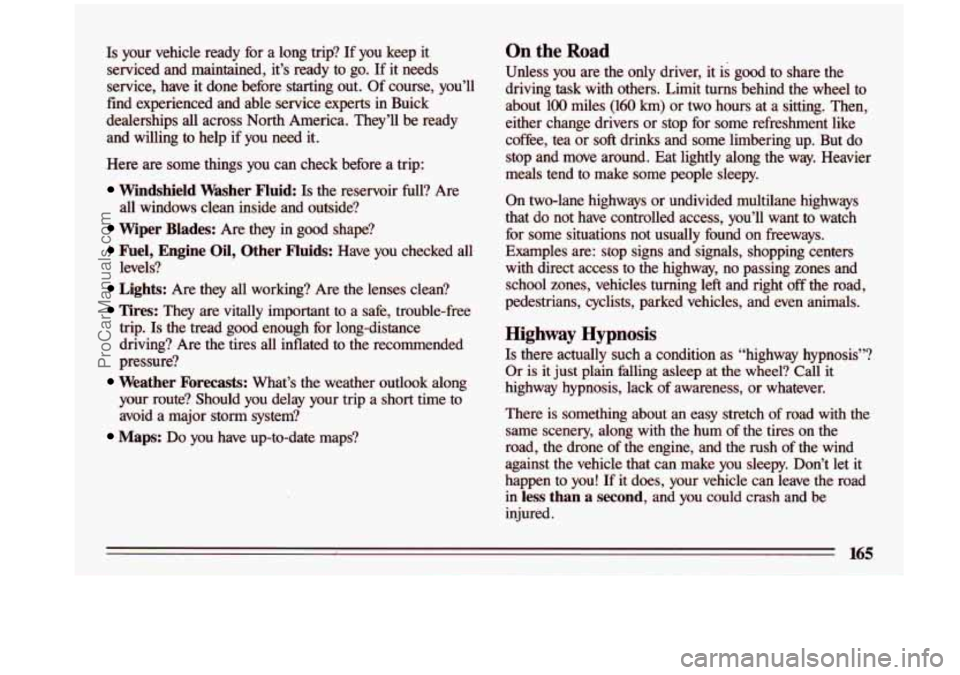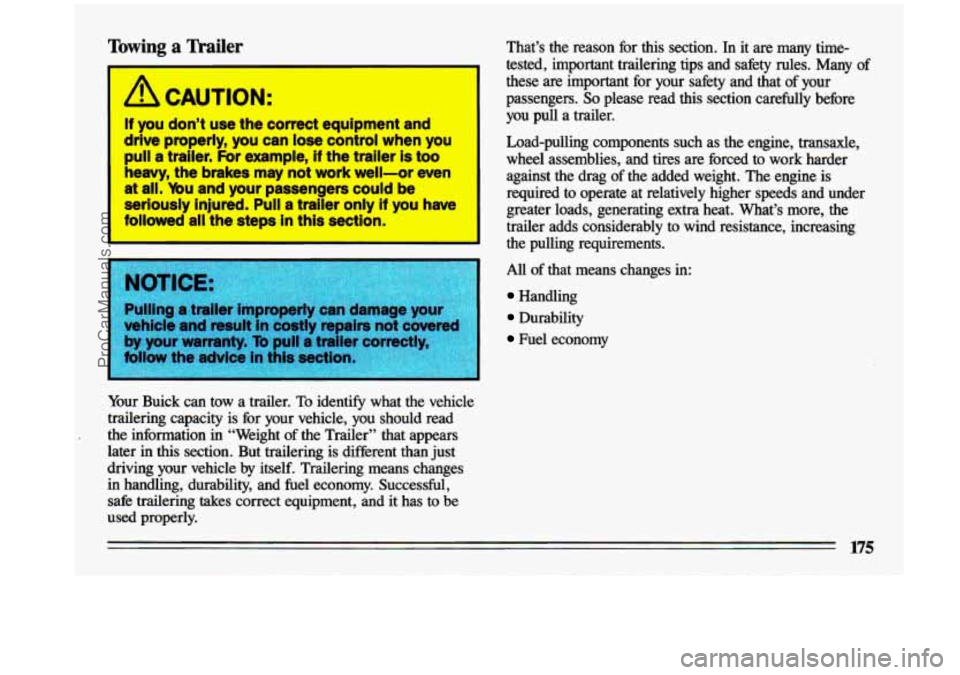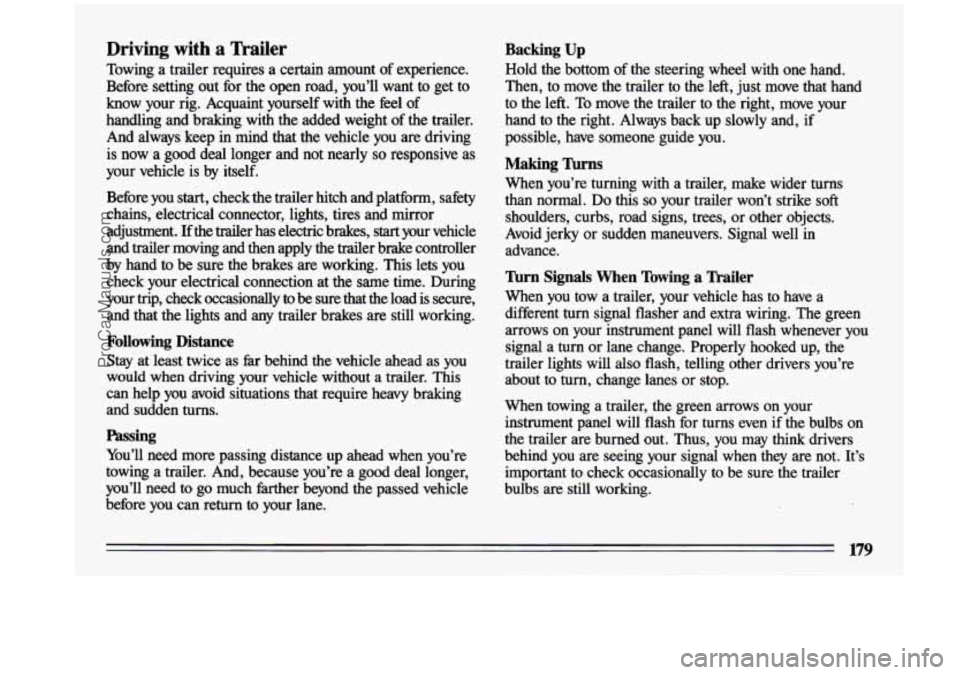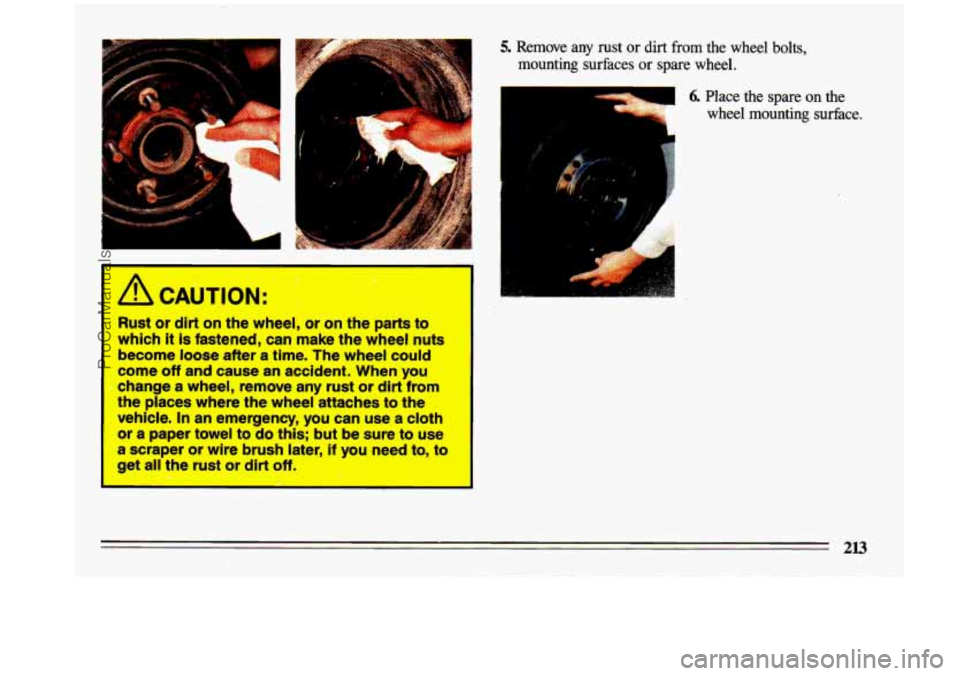1993 BUICK CENTURY change time
[x] Cancel search: change timePage 155 of 324

So here are some tips for passing:
“Drive ahead:’ Look down the road, to the sides, and
to crossroads for situations that might affect your
passing patterns. If you have any doubt whatsoever
about making a successful pass, wait for a better time.
Watch for traffic signs, pavement markings, and lines.
If you can
see a sign up ahead that might indicate a
turn or an intersection, delay your pass. A broken
center line usually indicates it’s
all right to pass
(providing the road ‘ahead is clear). Never cross a solid \
line on your side of the lane or a double solid line, even
if the road seems empty of approaching traffic.
If you suspect that the driver of the vehicle you want to
pass isn’t aware of your presence, tap the horn a couple
of times before passing.
Do not get too close to the vehicle you want to pass
while you’re awaiting
an opportunity. For one thing,
following too closely reduces your area
of vision,
especially if you’re following a larger vehicle. Also,
you won’t have adequate space if the vehicle ahead
suddenly slows or stops. Keep back a reasonable
distance.
When it looks like a chance to pass is coming up, start
to accelerate but stay in the right lane and don’t get too
close. Time your move
so you will be increasing speed
as the time comes to move into the other lane. If the
way is clear to pass,
you will have a “running start’’
that more than makes up for the distance you would
lose
by dropping back. And if something happens to
cause you to cancel your pass, you need only slow
down and drop back again and wait
for another
opportunity.
If other cars are lined up to pass a slow vehicle, wait
your turn. But take care that someone isn’t trying
to
pass you as you pull out to pass the slow vehicle.
Remember to glance over your shoulder and check the
blind spot.
start your left lane change signal before moving out of
the right lane to pass. When you are far enough ahead
of the passed vehicle to see its front
in your inside
mirror, activate your right lane change signal and move
back into
the right lane. (Remember that your right
outside mirror
is convex. The vehicle you just passed
may seem to be farther away from you
than it really is.)
Try not to pass more than one vehicle at a time on two-
lane roads. Reconsider before passing the next vehicle.
Check your mirrors, glance over your shoulder, and
ProCarManuals.com
Page 167 of 324

Is your vehicle ready for a long trip? If you keep it
serviced and maintained, it’s ready to go. If it needs
service, have it done before starting out.
Of course, you’ll
find experienced and able service experts in Buick
dealerships
all across North America. They’ll be ready
and willing to help if you need it.
Here are some things you can check before
a trip:
Windshield Washer Fluid: Is the reservoir full? Are
all windows clean inside and outside?
Wiper Blades: Are they in good shape?
hel, Engine Oil, Other Fluids: Have you checked all
Lights: Are they all working? Are the lenses clean?
Tires: They are vitally important to a safe, trouble-free
trip.
Is the tread good enough for long-distance
driving? Are the tires all inflated to the recommended
pressure?
Weather Forecasts: What’s the weather outlook along
your route? Should you delay your trip a short time to
avoid a major storm system?
levels?
Maps: Do you have up-to-date maps?
On the Road
Unless you
are the only driver, it is good to share the
driving task with others. Limit
turns behind the wheel to
about
100 miles (160 km) or two hours at a sitting. Then,
either change drivers or stop for some refreshment like
coffee, tea or
sol3 drinks and some limbering up. But do
stop and move around. Eat lightly along the way. Heavier
meals tend
to make some people sleepy.
On two-lane highways or undivided multilane highways
that do not have controlled access, you’ll want to watch for some situations not usually found on freeways.
Examples are: stop signs and signals, shopping centers
with direct access to the highway, no passing zones and school zones, vehicles turning left and right
off the road,
pedestrians, cyclists, parked vehicles, and even animals.
Highway Hypnosis
Is there actually such a condition as “highway hypnosis”?
Or is it just plain falling asleep at the .wheel? Call it
highway hypnosis, lack of awareness, or whatever.
There is something about an easy stretch
of road with the
same scenery, along with the hum
of the tires on the
road, the drone
of the engine, and the rush of the wind
against the vehicle that can make you sleepy. Don’t let it \
happen to you!
If it does, your vehicle can leave the road
in
less than a second, and you could crash and be
injured.
165
ProCarManuals.com
Page 177 of 324

Towing a Trailer
A CAUTION:
If you don’t use the correct equipment and
drive properly, you can lose control when you
pull a traller. For example, If the trailer is too
heavy, the brakes may not work well--or wen
at all. Mu and your passengets could be
seriously Injured. Pull a trailer only if you have
followed all the steps in this section.
hicle and result
Your Buick can tow a trailer. To identify what the vehicle
trailering capacity is for your vehicle, you should read
the information in “Weight of the Trailer” that appears
later
in this section. But trailering is different than just
driving your vehicle
by itself. Trailering means changes
in handling, durability, and fuel economy. Successful,
safe trailering
takes correct equipment, and it has to be
used properly. That’s the reason for this section.
In it are many time-
tested, important trailering tips and safety rules. Many
of
these are important for your safety and that of your
passengers.
So please read this section carefully before
you pull a trailer.
Load-pulling components such as the engine, transaxle,
wheel assemblies, and tires are forced to work harder against the drag of the added weight. The engine is
required to operate at relatively higher speeds and under
greater loads, generating extra heat. What’s more, the
trailer adds considerably
to wind resistance, increasing
the pulling requirements.
All of that means changes in:
Handling
Durability
Fuel economy
175
ProCarManuals.com
Page 181 of 324

Driving with a Trailer
Towing a trailer requires a certain amount of experience.
Before setting out for the open road, you’ll want to get t\
o
know your rig. Acquaint yourself with the
feel of
handling and braking with the added weight of the trailer.
And always keep in mind that the vehicle you
are driving
is now a good deal longer and not nearly
so responsive as
your vehicle is by itself.
Before you
start, check the trailer hitch and platform, safety
chains, electrical connector, lights, tires and mirror
adjustment. If the trailer has electric brakes,
start your vehicle
and trailer moving and then apply the trailer brake controller \
by hand to be sure the brakes
are working. This lets you
check your electrical connection at the same time. During
your trip, check occasionally
to be sure that the load is secure,
and that the lights and any trailer brakes are still working.
Following Distance
Stay at least twice as fit, behind the vehicle ahead as you
would when driving your vehicle without a trailer. This
can help you avoid situations that require heavy braking
and sudden turns.
Passing
You’ll need more passing distance up ahead when you’re
towing
a trailer. And, because you’re a good deal longer,
you’ll
need to go much farther beyond the passed vehicle
before you can return to your lane.
Backing Up
Hold the bottom of the steering wheel with one hand.
Then, to move the trailer to the left, just move that hand
to the left.
To move the trailer to the right, move your
hand to the right. Always back up slowly and, if
possible, have someone guide you.
Making nrns
When you’re turning with a trailer, make wider turns
than normal.
Do this so your trailer won’t strike soft
shoulders, curbs, road signs, trees, or other objects.
Avoid jerky or sudden maneuvers. Signal well in
advance.
Turn Signals When Towing a Mler
When you tow a trailer, your vehicle has to have a
different turn signal flasher and extra wiring. The green arrows on your instrument panel will flash whenever you
signal a turn or lane change. Properly hooked up, the
trailer lights will also flash, telling other drivers you’re \
about to turn, change lanes or stop.
When towing a trailer, the green arrows on your instrument panel will flash for turns even if the bulbs on
the trailer are burned out. Thus, you may think drivers
behind you are seeing your signal when they are not. It’s
important to check occasionally to be sure the trailer
bulbs are still working.
179
ProCarManuals.com
Page 215 of 324

I A CAUTION:
Rust or dirt on the wheel, or on the parts to
which
it is fastened, can make the wheel nuts
become loose after a time. The wheel could
come
off and cause an accident. When you
change a wheel, remove any rust or
dirt from
the places where the wheel attaches to the
vehicle. In an emergency, you can use
a cloth
or a paper towel to do this; but be sure
to use
a scraper or wire brush later, if you need to, to
get all the rust or
dirt off. ’. : .a.
I
5. Remove any rust or dirt from the wheel bolts,
mounting surfaces
or spare wheel.
6. Place the spare on the
wheel mounting surface.
ProCarManuals.com
Page 234 of 324

When to Change Engine Oil: See if any one of these is
true for you:
Most trips are less than 4 miles (6 km).
It’s below freezing outside and most trips are less than
10 miles (16 km).
The engine is at low speed most of the time (as in
door-to-door delivery,
or in stop-and-go traffic).
You tow a trailer often.
Most trips are through dusty places.
If any one of these is true for your vehicle, then you need
to change your oil and filter every 3,000 miles
(5 O00 km) or 3 months-whichever comes first.
If none
of them is true, change the oil every 7,500 miles
(12 500 km) or 12 months-whichever comes first.
Change the fdter at the first oil change and at every other
oil change afier that.
Engine Block Heater: An engine block heater can be a
big help if you have to park outside
in very cold weather,
0°F (-18°C) or colder. If your vehicle has this option, see
“Engine Block Heater”
in the Index.
What to Do with Used Oil:
-
/i CAUTION:
Used engine oil contains things that have
caused skin cancer in laboratory animals.
Don’t let used oil stay on your skin for very
long. Clean your skin and nails with soap and
water or a good hand cleaner. Wash or
properly throw away clothing or rags
containing used engine oil.
Used oil can be a real threat to the environment. If you
change your own oil, be sure to drain all free-flowing oil
from the filter before disposal. Don’t ever dispose of oil
by pouring it on the ground, into sewers, or into streams
or bodies of water. Instead, recycle it ‘by taking
it to a
place that collects used
oil. If you have a problem
properly disposing of your used oil, ask your dealer, a
service station or a local recycling center for help.
232
ProCarManuals.com
Page 238 of 324

Automatic ‘mansaxle Fluid
When to Check and Change:
A good time to check your automatic transaxle fluid level
is when the engine oil is changed. Refer to the
Maintenance Schedule to determine when to change your
fluid. See “Scheduled Maintenance Services” in the
Index.
How to Check:
Because this operation can be a little difficult, you may
choose to have
this done at a Buick dealership Service
Department.
If you do it yourself, be sure to follow all the instructions
here, or you could get a false reading on the dipstick. Wait at least
30 minutes before checking the transaxle
fluid level
if you have been driving:
When outside temperatures are above 90°F (32°C).
At high speed for quite a while.
In heavy traffic-especially in hot weather.
While pulling a trailer.
To get the right reading, the fluid should be at normal
operating temperature, which is
180°F to 200” F (82” C to
93°C).
Get the vehicle warmed up by driving about 15 miles
(24 km) when outside temperatures are above 50°F
(10°C). If it’s colder than 50” F (lO°C), you may have to
drive longer.
To check the fluid level:
Park your vehicle on a level place.
0 Place the shift lever in “P” (Park) with the parking
brake applied.
With your foot on the brake pedal, move the. shift lever
through each gear range, pausing for about three
seconds in each range. Then, position the shift lever in
“P” (Park).
Let the engine run at idle for three to five minutes.
236
ProCarManuals.com
Page 246 of 324

Replacing Brake System Parts
The braking system on a modern vehicle is complex. Its
many parts have to be of top quality and work well’
together
if the vehicle is to have really good braking.
Vehicles we design and test have top-quality
GM brake
‘parts in them, as your Buick does when it is new. When
you replace parts of your braking system-for example,
when your brake linings wear down and you have to have
new ones put in-be sure you get new genuine
GM
replacement parts. If you don’t, your brakes may no
longer work properly. For example, if someone puts in
brake linings that are wrong for your vehicle, the balance
between your front and rear brakes can change, for the worse. The braking performance you’ve come to expect
I
can change in many other ways if someone puts in the
wrong replacement brake parts.
Battery
Every new Buick has a Delco Freedom@ battery. You
never have
to add water to one of these. When it’s time
for a new battery, we recommend a Delco Freedom*
battery. Get one
that has the catalog number shown on
the original battery’s label.
Vehicle Storage
If you’re not ‘going to drive your vehicle for 25 days or
more,
take off the black, negative (-) cable from the
battery. This will help keep your battery from running
down.
A CAUTION:
Batteries have acid that can burn you and gas
that can explode.
Ybu can be badly hurt if you
aren’t careful. See “Jump Starting” in the ldex for tips on working around a battery
without getting hurt.
Contact your dealer to learn how to prepare your vehicle
for longer storage periods.
244
ProCarManuals.com